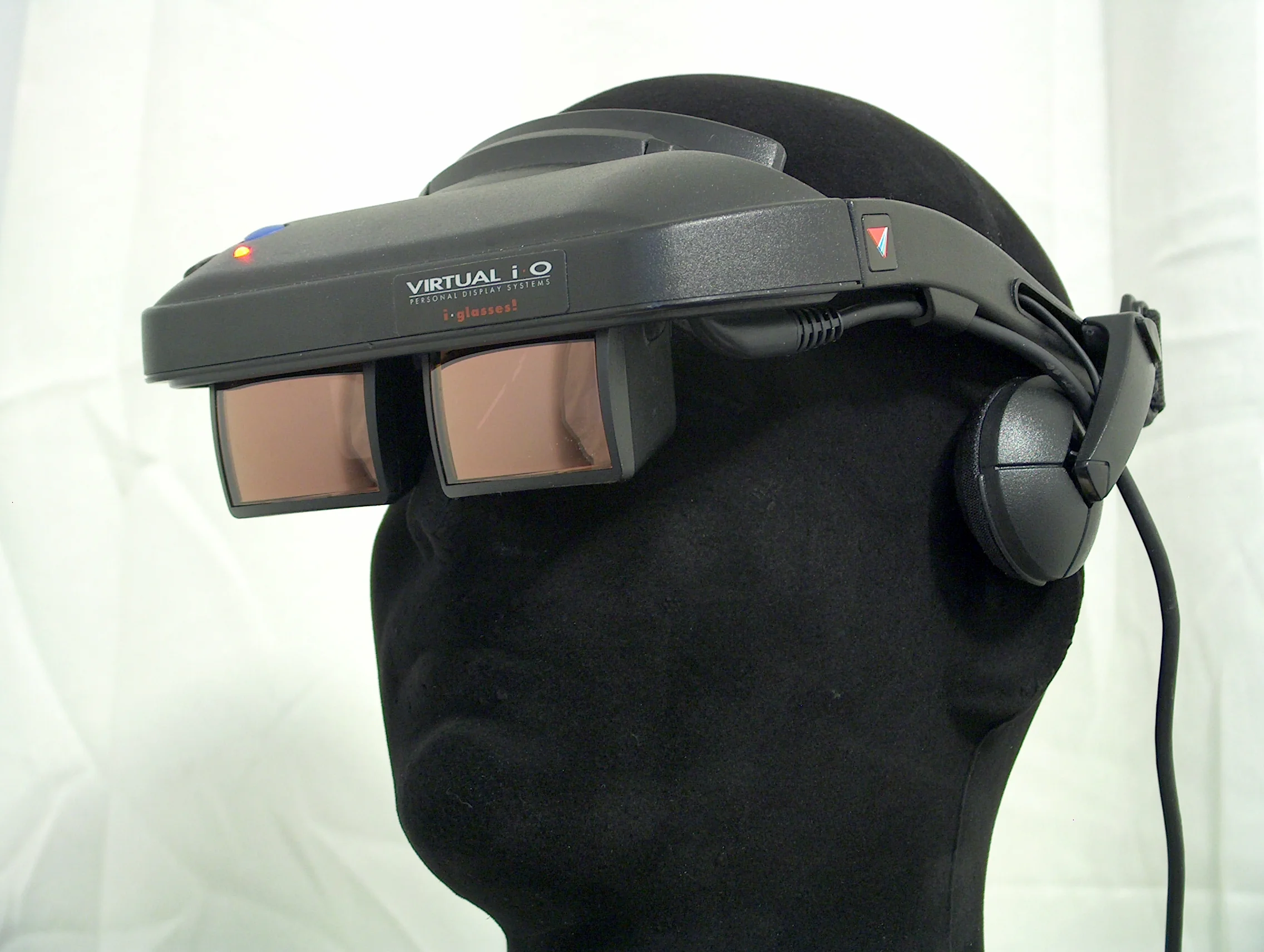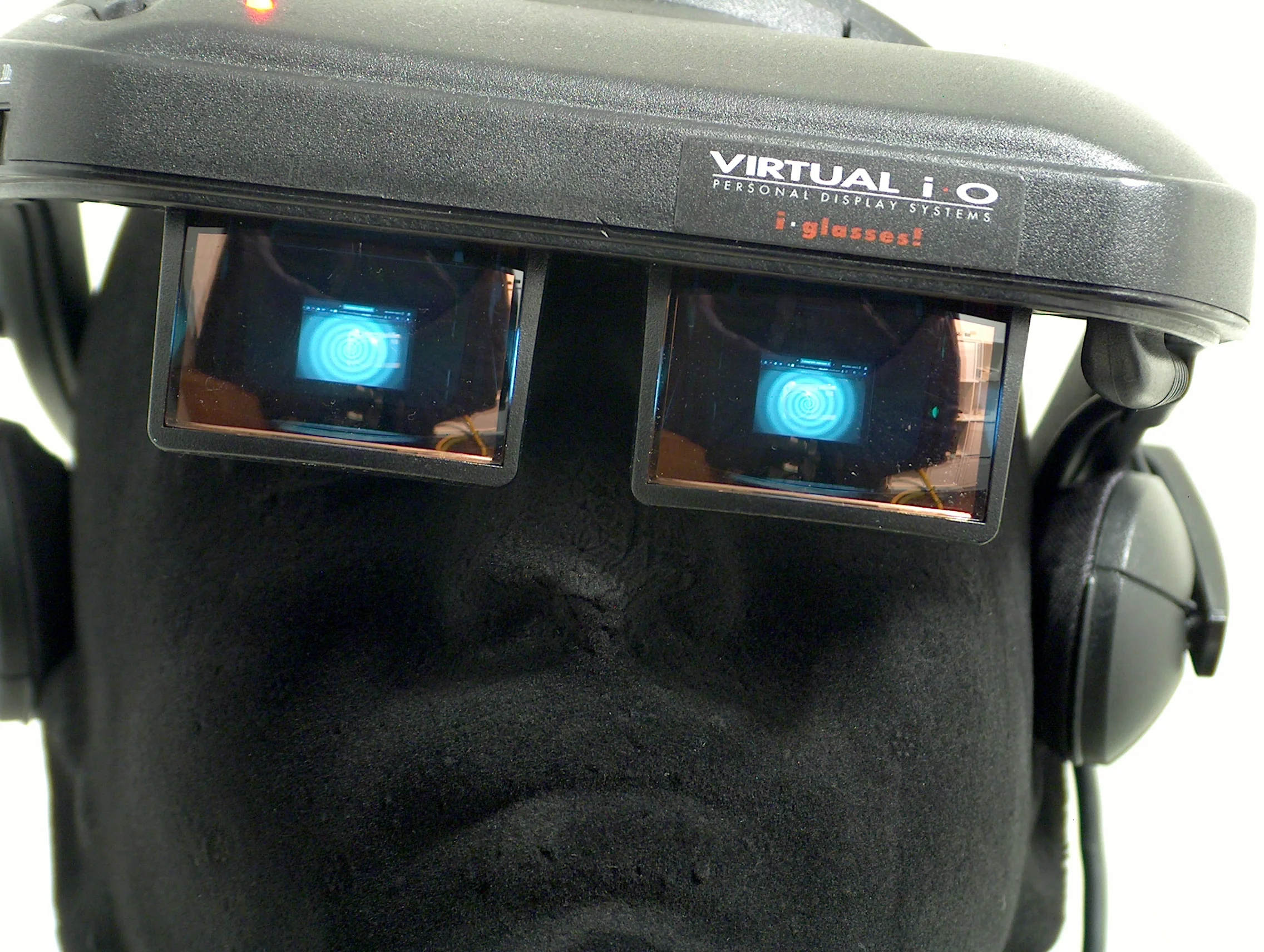Hypnosis Visuals Like You're In A Mad Scientist's Lab In 1994
by portalz on 2025-03-22 00:00:00
If you're under 18, please stop reading here. This article is about using VR equipment for weird kink stuff, primarily hypnosis.
If you worked for Virtual I/O back in its heyday, I'm so sorry for what you're about to read. Additionally, if you know someone who recently bought this same headset and has been doing things with it, they're a different person.
All photos in this article were taken with a quite frankly terrible early 00's digital camera that I got at a thrift store. It has a vibe to it and also leaves no useful metadata that I would otherwise have to clean up.Background
A few weeks ago, I was thinking back to the movie Hackers (1995), where the character Eugene Belford (played by Fisher Stevens) plays some kind of game in VR. Specifically, he's using a system by a company called Virtuality. Nowadays, they're incredibly rare. They were sold as massive systems for arcades, and they never really had a commercial product.
Nintendo's VirtualBoy is one of the most well-known early commercial VR products, but the thing about it is, it both sucks and is impossible to feed arbitrary content to. There's also the Sony Glasstron, which isn't technically a VR headset, it's just a video display.
In the mid 1990s, a small Seattle-based startup called Virtual i-O created what is one of the closest early comparable systems to the VR headsets we have today with their i-glasses headset. With the PC interface, they can do built-in head tracking with what I assume is probably an accelerometer. I'm not really keen on the idea of taking it apart. The PC interface box emulates a serial mouse, so it's great if you hate yourself enough to want to play DOOM in VR or something. Officially, it's only supported by a handful of games, such as Heretic. A copy of Heretic came with my set.

In its most basic form, Virtual i-O's i-glasses do basically the same thing as the Sony Glasstron. It takes a baseband NTSC video input over a set of RCA composite connectors, but can take a PC input over VGA by swapping out the cable and input box. For most of these experiments, I'll be using the headset with the video interface, because the rear head pack for the PC interface is covered in sticky 30 year old foam and I don't feel like cleaning it yet. I'm also not super optimistic in the ability to use a serial mouse to pan around any kind of modern VR software. It might work for desktop-mode VRchat.
Another neat feature of the headset is that the lenses are semi-transparent, allowing you to see what's on the screen from the outside (just barely!). For hypnokink things, that's hot as fuck. Imagine looking into your subject's eyes and they're overlaid with spiral visualizations.
Technical Specs
Diving into an old PDF for the developer kit, it has a few supported video modes:
- NTSC Composite
- VGA modes 1h-13h, including unchained modes ('X')
- Enigma 320x200
For stereo, it has a variety of other supported modes, which all boil down to two main categories.
- Field Sequential (every other field goes to each eye)
- Frame Sequential (every other frame goes to each eye)
Connecting the i-glasses to a computer with the video interface
For most of this, I used a couple of laptops because I can't be bothered to string this into the absolute hell that is my desktop PC wiring. To get a baseband NTSC signal into it from a modern computer, I need a couple of adapters. I happen to have a TV Superscan 2 scan converter from sometime in the 90s, which should be fine for the final step in the chain, converting VGA to NTSC baseband. I also have an HP Thunderbolt G2 dock, which has a VGA port.
Unfortunately, it wasn't that simple. It's never that simple. The TV Superscan 2 is old enough that it just expects something to blindly scream a video signal into it, and the Thunderbolt dock is new enough that it won't output on the VGA port unless it knows a monitor is there. I bought the first result for "VGA edid injector" online, and that did the trick. It's just a little passthrough plug that siphons just enough power to power a chip identify itself as a monitor with support for up to 1920x1080 @ 60hz. I don't really know how EDID works, and I don't really care to read too much into it, but this does the trick.

I did the most obvious first thing once I got my computer to feed output to the headset: I pulled up Nimja's spiral generator. It's beautiful.
Trying some Normal things
For all of these, I just used it as an HMD, because I can't use tracking in modern games without a lot of hoops that I'm not prepared to jump through.
Antichamber
I tried playing Antichamber. Everything is impossible to read unless you get right up against the sign. Some dark areas just become an unnavigable grey blur. It's not awful, but I really wouldn't recommend it.
Superliminal
I tried out Superliminal. Depending on the stage, it ranges from okay to completely unplayable. Some areas require moving objects far away, and it's difficult to get them placed on pressure pads because there aren't enough pixels and the shadows are near invisible because of the poor dynamic range.
Garfield Kart: Furious Racing
Don't.
Trying some Not-So-Normal things
Hypnokink
Of course, the entire point of this exercise was to mess with hypnokink with 1990s VR gear. I did a roughly two hour session on a soft blanket surrounded by supportive pillows.
In my very scientific test, my set consisted of (all by Esuccubus):
- Long Resistance Induction
- Ode To Good Moos (I think, it was definitely one of the cowgirl files
- Quick Amnesia Instruction Awakener
Honestly, I'm not really sure what, if anything, the Virtual i-O iGlasses added to the experience. I did go under, which is rare for me, but I don't think that's particularly attributable to the iGlasses. Pretty early on, I think, I got eye strain and ended up closing my eyes for the majority of the session. I remember some occasional eye flickers open back to spirals, but it was mostly just a black void. I think the eye strain kind of kills the feasibility of the whole thing for this, the backlight is just harsh. I personally wouldn't recommend it. That said, I've gotten a few more terrible 1990s VR headsets that I'm planning to try out sometime and maybe write more about.
Further reading
Have questions or comments?
hit me up on:
- discord: portalz
- websiteleague: [email protected]
- bluesky: portalz.bsky.social
- email: [email protected]
—portalz